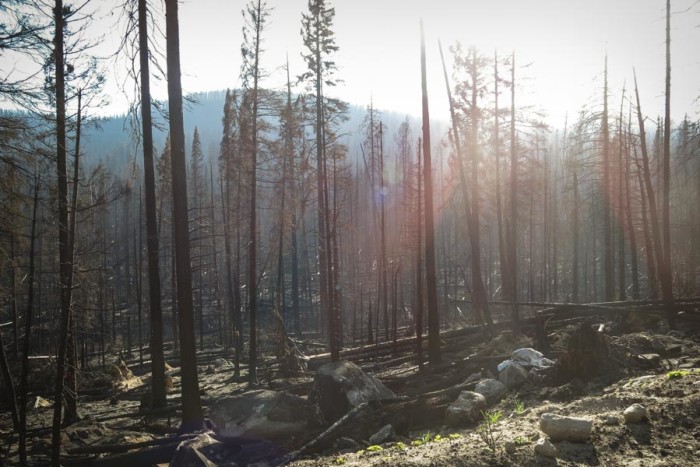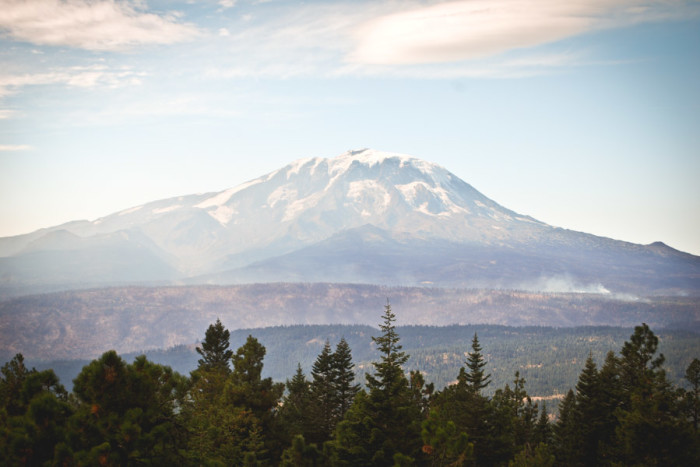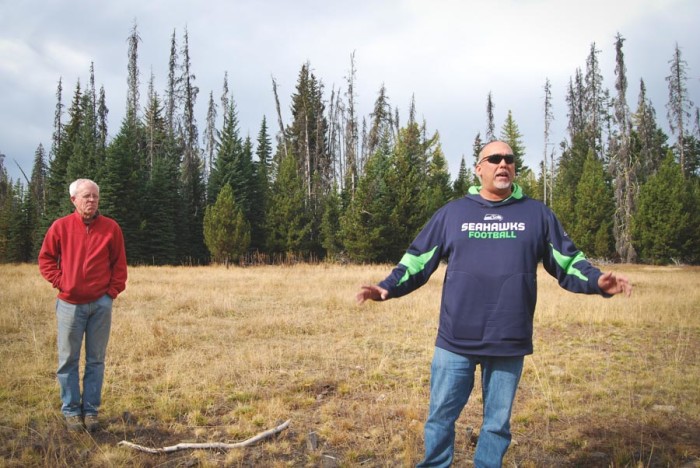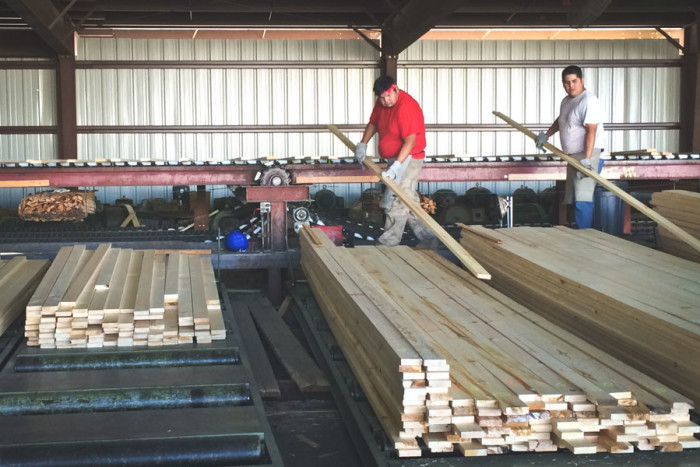
It’s an understatement to say that 2015 was a devastating year for wildfires in the Pacific Northwest.
Unusually warm and dry weather had our state in emergency drought since May. Conditions were ripe for fires to spread rapidly – and that’s exactly what happened this summer. The fires were so large that teams from all over the U.S., Canada, and even Australia flew in to help. As of September, more than one million acres of land burned in Washington.
But lost in the coverage of flames converging on multimillion dollar houses was the fact that much of what burned was tribal land.
Earlier this month I visited the Yakama Nation alongside a group of University of Washington graduate students. From Signal Peak, a lookout point atop a windy hill in the center of the tribe’s closed reservation area, I could see smoke swirling up from the treeline at the foot of Mount Adams. The fire, which began in August, had already burned 41,000 acres of the Yakama tribe’s forest. And it was still smouldering away.
Part of the problem was that resources that could have been fighting fires on the reservation were sent off to places like Chelan, peppered with expensive summer vacation homes, according to Phil Rigdon, president of the Intertribal Timber Council and superintendent of the Yakama Nation’s Department of Natural Resources.
“The priority went to homes that none of my [Yakama] members can afford to purchase… Who is taking the burden of the fire? It ends up being us because our tribe chose not to have those types of developments in our forested area,” said Rigdon.
The new normal
Despite firefighting efforts, tribal nations were hit particularly hard by wildfire – the Tunk Block and North Star fires in the northeastern part of the state burned on the Colville reservation and the Cougar Creek fire in south-central Washington burned portions of the Yakama reservation.
“We end up hurting ourselves because we can’t get the resources when an event like this happens. I don’t want to discount the value of those homes,” Rigdon said, “but we don’t have insurance for our forest.”
To date, this summer’s fires are the largest Yakama and Colville leaders have ever seen according to Rigdon.
“That’s the concern,” he said. “Going forward, is this the new norm?”

Chris McCuen, emergency manager for the Colville tribe says that In the last decade it was common to see wildfires that were between 50 and 100 acres, which were considered manageable.
“Now, we say [the same for] 1,000 acres. The fires are becoming larger and more intense,” McCuen said.
Just two years ago, the Yakama fought off the Mile Marker 28 fire, which burned about 26,000 acres of tribal and state forest land – then the largest fire tribal leaders had ever seen. This year, the Cougar Creek fire burned about 6 percent, or about 41,000 acres of the Yakama’s forest lands.
The two wildfires that hit the Colville reservation burned more than 20 percent, or 270,000 acres, of reservation lands. Fifteen homes were also lost to the fires.
Resources spread thin
But how did the fires become so devastating in the first place? According to officials on the Yakama and Colville tribal reservations, it was because of a lack of resources.
“For the first four days, we had 100 people [working on the fires] … That’s how short on resources we were,” said McCuen. “In any other year, we’d have 1,000 to 2,000 people on it in the first two days.”
But with fires threatening residential areas elsewhere in the Pacific Northwest, heavily forested tribal lands took a backseat.
“Quite frankly, because we’re on a reservation, it’s quite rural, so homes are very scattered. So we are at the bottom of the list,” said McCuen.
In terms of which fires are fought first, the number one priority is to protect human life, said Robyn Broyles, a spokesperson for the National Interagency Fire Center, which dispatches resources and fire crews to fight wildfires across the United States. The organization’s second priority is to protect community infrastructure, which includes buildings, property, and natural and cultural resources.
“[For tribes], they live off the land and they depend on those resources for their economic revenue,” she said. “And when it comes to timber, it’s not just [about] them, it’s their generation and generations [ahead] that are impacted by that loss.”
Broyles recognizes that those cultural values are vital to communities like the Yakama and Colville. But when fires are raging across the Northwest as they were this summer, national and regional agencies have to allocate already scarce resources to the most densely populated areas.

Stopping wildfires before they start
It’s not just about a lack of resources to fight fires once they’re out of control. Prescribed or controlled fires have been one of many forestry management tools in tribal cultures for thousands of years. Following the devastation of tribal societies by European settlement, there weren’t many people left to care for the land, making it harder to continue those traditions, said Spus Wilder, a Colville tribal forestry research consultant.
Today, there simply isn’t enough funding and specialized fire crews to use prescribed fires as a preventative measure for forest fires, said Ernesto Alvarado, a fire ecology professor at the University of Washington and member of the Intertribal Timber Council.
“Since there is no direct threat to homes in the forest, their budgets are reduced drastically,” he said.
And for tribal leaders and their communities, this is difficult to grapple with. For the Yakama people, their land is the center of their world, a holy land, even, said Arlen Washines, Yakama tribal elder and program manager for the Northwest Tribal Horse Coalition.
“For us, the native people, that is our home,” he said.
The forest economy
Beyond their spiritual significance, forests are also a huge part of the tribal economy. On the Colville reservation, timber accounts for about a third of the tribal budget. And the forestry industry is one of the biggest employers on the Yakama reservation.
But their current workforce isn’t large enough to salvage the wood from thousands of acres of burned forests, said Phil Rigdon’s brother Steve, who is assistant forest manager for Yakama Forest Products.
According to Steve, the Yakama’s forestry workers and their partners have about six months to salvage 10,000 acres of good-quality timber killed by the fires before it rots. Realistically, their crews will be able to harvest about 5,000 acres in the coming months, which could generate $50 million.
“The biggest issue is that we are only salvaging 30 percent of what burnt up. That’s the sad part,” he said.

Rigdon believes an accurate assessment of the loss from the wildfires this year means looking ahead as much as a century. Over the next hundred years, the tribe will lose about $500 million as a result of the Cougar Creek fire. And it’s not just about the money.
“When the timber burns up, this isn’t just ground that we can let go for a few years. This is ground we rely on to raise our livestock, to gather our food and medicines,” said McCuen back at the Colville reservation. “This is where we take our children to learn about the world around them. This is where we hunt. This is where we fish. This is where we live. This is devastating for us.”
Looking forward seven generations
Recovering from that kind of devastation is a slow process. That’s clear looking at the sites where the Mile Marker 28 fire burned on the Yakama reservation in 2013. The charred skeletons of pine trees still stick out of the hillside, with seemingly no growth on the forest floor below them. Massive piles of burned wood dot the roadside.
The Yakama forest department remains hopeful they can restore the land. But in the meantime, there’s a lot of work to be done to figure out a better way to deal with next year’s fires.
“I believe this fire season was a good example of opportunities that we at the Bureau of Indian Affairs have to learn how we discuss and talk about priorities,” said Broyles. “With the discussions that have come out of this season, there’s future opportunity for the Bureau of Indian Affairs to come back to the Multiagency Coordinating Group and discuss how we might better allocate resources that are more equitable and not just equal.”
For the Yakama, this reevaluation of priorities can’t come soon enough. For a tribal community already facing high rates of poverty and unemployment, scarce resources during tragedies like the Cougar Creek fires is just another painful blow.
“You’re talking about water quality, fisheries, habitat … You cannot monetize those things. Those things are invaluable. They’re precious,” Rigdon said. “You have to look forward seven generations and take care of those people. And we can’t.”


These forests are meant to burn. Its natural for the forests in this region to burn periodically. Let them burn and the forest will be healthy.
If you live in the forests then build properly or don’t live there.
thanks 4 the informative article. Would that there were sufficient funds to do more wildfire fuel reduction. Cutting down and removing saplings and shrubs that become fuel for the megafires.
Hey The The. The forests are not “meant to burn” in these new megafires. They are meant to burn in the small more or less self contained “natural” fires.